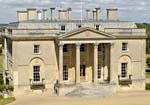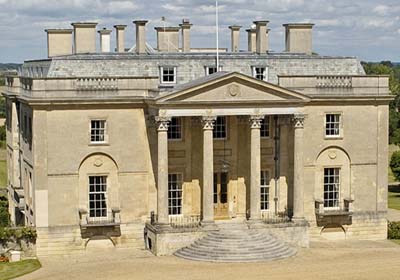Classic country houses for sale in the Cotswolds
The big guns are coming out this year in the Cotswolds, with some real quality country houses coming up for sale


What a difference a year makes. For the first time since the start of the recession, the big guns are out in the Cotswolds again. ‘Compared with a year ago, it's a completely different marketplace: we are now seeing a marked increase in both the quality and quantity of new stock coming on,' reveals Atty Beor-Roberts of Knight Frank's Cirencester office. Proof of the pudding is the launch by Knight Frank (020-7629 8171) in this week's Country Life of no fewer than 15 prime Cotswold country houses, all brand new to the market, and valued individually from £1.1 million to £20 million-some £60m in all.
Leading the charge, at £20m, comes Dr Michael Peagram's palatial Georgian mansion, Grade II*-listed Bletchingdon Parkat Bletchingdon, eight miles from Oxford. Owned by the Monaco-based philanthropist and chemicals industrialist since 1993, the 22,600sq ft Palladian masterpiece was rebuilt on the site of an even larger house to the designs of the architect James Lewis by Arthur Annesley, Viscount Valentia, in 1782. During his tenure, Dr Peagram, who retains close links with Oxford, has had the building meticulously restored to residential use by historic-building specialist Symm.
Set in 127 acres of historic, wooded parkland first mentioned in Domesday, Bletchingdon Park (pictured) stands at the head of a long, sweeping drive looking out over swathes of manicured green lawns and Oxfordshire countryside to the Chilterns beyond. The present house stands on the site of a medieval manor house rebuilt, at vast expense, by Sir Thomas Coghill in about 1630. That house was evidently conceived on a grand scale, as it was fortified and garrisoned by 200 of the King's men during the Civil War, before being over-run by Cromwell's troops in 1644.

It was still one of the largest houses in the county when the Coghill family sold it to Lord Valentia in 1716. The estate remained in the Valentia family until the mid 20th century, when it was bought by Lord Astor, and later Lord Rotherwick. No stranger to grand living, Bletchingdon Park is likely to appeal to an exclusive coterie of national and international buyers, thanks to its wonderful setting and peerless location within easy reach of Oxford, with Kidlington private airport on the doorstep, suggests Rupert Sweeting of Knight Frank.
Grand it certainly is, with Classical, well-proportioned reception rooms, including a reception hall, a drawing room, a dining room, a sitting room, a library/study and a saloon to the rear of the house, with three sets of glass doors opening onto the rear portico, and steps leading down to the gardens. The garden floor provides further reception space, with the garden room-ideal for informal entertaining-leading onto the paved garden terrace, the billiards room, the fitness room and the spa. The main bedrooms-master suite, four further suites, a guest bedroom and a family bathroom -are on the first floor, with three bedrooms, two bathrooms and two staff flats on the second floor.
Were it not for its ‘excess £8m' price-tag, lovely, Grade II*-listed Broadwell Manor at Broadwell, near Stow-on-the-Wold, Gloucestershire, would sit right at the top of any Cotswold country-house seeker's shopping list. Nevertheless, being precisely the kind of good family house that has been conspicuously lacking in these parts in recent years, it's still likely to appeal to a broad spectrum of buyers, both locally and from further afield.
The manor stands on the edge of the pretty village of Broadwell, on a site owned by the abbey of Evesham from 708 until the Dissolution in 1540, when it reverted to the Crown. In 1619, it was bought by the Hodges family and passed down the female line until 1971, when it was sold. The original manor house was of late Tudor/early Jacobean origin, of which only a small part survived a fire in the mid-1700s. The present house was rebuilt in 1757 by Mary Chamberlayne, who inherited the estate, and her husband, Dr Thomas Chamberlayne; further extensions were added in the early 19th and the 20th centuries.
Exquisite houses, the beauty of Nature, and how to get the most from your life, straight to your inbox.
For the past 26 years, the manor has been the much-loved and beautifully maintained home of Mrs Sarah Shearer, who plans to downsize and move to Cornwall now that her children have flown the nest. The 13,100sq ft house stands in 35 acres of landscaped gardens, grounds and fields, and has three main reception rooms, a kitchen/breakfast room, a garden room, an entertaining room, eight bedrooms, seven bathrooms, a second-floor sitting room and study and a large one-bedroom first-floor flat. Secondary buildings include a studio, four cottages, stabling and stores.
Finally, the unspoilt Cotswold Georgian gem that everyone dreams of owning: Grade II-listed Pudlicote near Chadlington, five miles from Chipping Norton, combines history, heritage and Classical proportions under its L-shaped roof. The Pudlicote estate was associated in medieval times with the notorious John de Pudlicote, who, in 1303, attempted to steal the Crown Jewels from the Chapel of the Pyx in West-minster, and was caught and hanged for his pains.
The present Georgian country house was built on the site of a Roman villa for the Gorge family in about 1810. For more than 40 years, Pudlicote has been the home of longstanding Heythrop Hunt supporter Lady Bolton and her late husband, shipping expert Sir Frederic Bolton, who died in 2005, aged 84. Their home reflects their lifelong passion for hunting and the countryside, although the agents would expect a new owner to carry out ‘a general 30-year makeover'.
Pudlicote sits at the end of a tree-lined gravel drive, surrounded by 38 acres of gardens and parkland running down to the River Evenlode. Knight Frank quote a guide price of £5m for the main house, the stable yard, the coach house and buildings, with the surrounding 38 acres; an additional 80 acres of parkland are on offer for a further £500,000. The 10,830sq ft main house is typical of its vintage, with an impressive, full-height reception hall, large, bright rooms with good ceiling heights, tall sash windows, panelled doors and large fireplaces. It has four reception rooms, a library, a kitchen/breakfast room, a games room, eight bedrooms, three bathrooms and a self-contained staff flat.
* Subscribe to Country Life and save £40%
Country Life is unlike any other magazine: the only glossy weekly on the newsstand and the only magazine that has been guest-edited by His Majesty The King not once, but twice. It is a celebration of modern rural life and all its diverse joys and pleasures — that was first published in Queen Victoria's Diamond Jubilee year. Our eclectic mixture of witty and informative content — from the most up-to-date property news and commentary and a coveted glimpse inside some of the UK's best houses and gardens, to gardening, the arts and interior design, written by experts in their field — still cannot be found in print or online, anywhere else.

